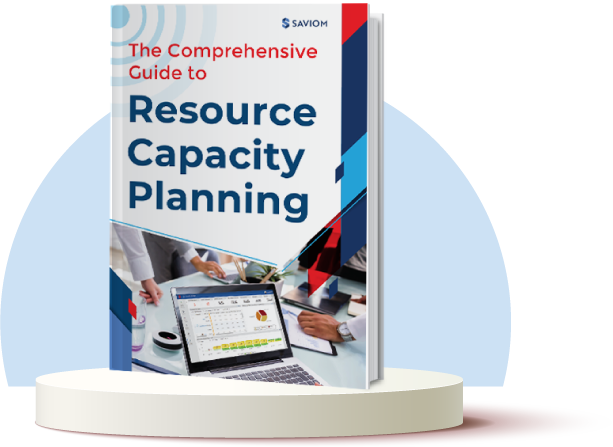Resource planning is a critical pillar for efficient resource management. Gauging the resources’ availability, scheduling, and keeping track of their utilization is key to accurate resource management.
However, this cannot be done when your firm does not have a standardized procedure to track and measure these parameters.
Moreover, the absence of a unified measure can lead to inaccuracies in project planning, causing billing loss in the future. It’s high time to put an end to these inadequacies and give your resource management process an edge.
This is where the Full-time Equivalent or F.T.E model comes into picture. It expresses the total workload of an employee in a standardized manner, regardless of whether they work full-time, part-time, or on a temporary basis.
This blog entails an in-depth description of two different measures- FTE (Full-time equivalent) and Hours, that benefit specific industries and give you precise, valuable insights into their KPIs.
Let’s begin with understanding all about the full-time equivalent,
What is FTE or full-time equivalent?
FTE, or full-time equivalent, is a unit of time defined to measure the workload, availability, or capacity of an employee. In other words, it is the hours worked by a single employee on a full-time basis.
It is a standardized measure to calculate project hours and staff count. In a nutshell, it is a comprehensive measure of the upcoming projects and tasks and the total number of people you plan on scheduling for these tasks. It also eliminates the ambiguity revolving around FTE vs. headcount.
Now that you are clear about the FTE meaning, let’s understand its benefits in detail:
Now that you are clear about the FTE definition let’s understand its benefits in detail:
What are the benefits of FTE?
Some FTE benefits are listed below:
-
Improves project management
The FTE model provides a standardized approach for calculating the demand for future projects and the number of hours required to accomplish tasks. For example, if your project needs 400 work hours, you can equate it to 9.41 FTE (400/42.5 hours) for five days. Accordingly, you can hire nine full-time and one part-time worker to fulfill the project demand. Hence, it enhances the project management process and ensures successful delivery.
-
Provides accurate understanding of workforce composition
Unlike headcount, FTE takes into account both full-time and part-time workers within the organization. This comprehensive view allows businesses to make informed decisions regarding when to hire part-time or full-time employees. By hiring the right professional, organizations can control project resource costs and ensure smooth organizational workflow.
-
Evaluates role-based capacity
FTE tracking allows you to aggregate the capacity of role-based employees. For example, if there are 20 content writers with a capacity of 0.7 FTE each, their aggregate will come up to 14.0 FTE. You can use the sum for accurate role-based resource management and task allocations.
-
Ensures uniform workload distribution among employees
Using the FTE model, managers can ensure that tasks are distributed evenly among the team members. For example, in the marketing department, the FTE of 3 employees are 1.0 FTE, 0.5 FTE, and 0.75 FTE. By allocating tasks based on FTE, managers can ensure that each employee’s workload is proportional to their capacity, and no one is overloaded or underworked.
Now that the benefits are understood let’s move to the next part to understand which industries benefit the most from the FTE model.
Read More: What is Resource Planning, and Why is it Important in Project Management?
When should you use FTE?
If you are planning a large-scale project that will continue for months and require extensive hourly calculations, FTE tracking can work wonders for you. You no longer have to calculate the work hours and headcount separately.
The full-time equivalent is ideal for Engineering and Construction projects. They have projects that last for months, and they end up hiring contractors on a large scale. However, with ‘guesstimation,’ they either equip excess capacity or find contracts expiring mid-projects.
So, when implementing this unified measure, you must draw up a clear project plan in advance and allocate resources accordingly.
FTE vs. Headcount
Nowadays, companies are leaning towards the FTE model as opposed to the headcount for many reasons. Firstly, headcount does not consider the number of part-timers in a firm. This can lead to over-hiring of employees. For two, it focuses on the overall organizational strategy and filling roles in general but does not drill down to closing the specific skill gaps.
How to calculate FTE?
As discussed earlier, FTE provides a standardized measure of employee work hours, allowing businesses to understand and optimize their staffing levels. Let’s now delve into the step-by-step process of calculating FTE.
Establish the standard working hours of the employees
Prior to calculating FTE, organizations must establish the standard weekly working hours expected from full-time employees while excluding any unpaid hours or time off.
For example, if an organization follows a 42.5-hour work week (equivalent to 1 FTE), this signifies that employees are scheduled to work 8.5 hours a day for five days every week.
Calculate the total hours worked by employees
To accurately calculate FTE, it is imperative to consider both full-time and part-time employees. Full-time employees’ total hours worked per week match the standard working hours (e.g., 42.5 hours). For part-time employees, their hours worked per week should be calculated proportionally.
For instance, if you have three full-time employees and two part-time employees who work three days a week, the total hours worked by all employees would be:
Full-time employees: 3 x 42.5 = 120 hours
Part-time employees: 2 x (3 days x 8.5 hours/day) = 51 hours
Total weekly hours for all employees: 127.5 + 51 = 178.5 hours
Divide the total work hours by the standard working hours
Now, one must divide the total hours worked by all employees in a week (i.e., 178.5 hours) by the standard working hours per week (42.5 hours for 1 FTE). This calculation provides the full-time equivalent (FTE) for your entire organization.
As stated in the example in the prior section, the total hours worked by all employees is 178.5. Divide this by the standard 42.5-hour workweek:
178.5/42.5 hours = 4.20
So, within your organization of 5 employees, you have 4.20 FTE.
Round the number to the nearest hundredth
Depending on the calculation, you may obtain a decimal value. To simplify and manage the number, round it to the nearest hundredth.
In our example, as the FTE is 4.20, it means the organization has the equivalent of 4.20 full-time employees working on the projects.
Now, let’s understand how to calculate FTE for various types of employees in detail.
How to calculate FTE for various types of employees?
Calculating FTE isn’t a one-size-fits-all process, as different types of employee categories, such as full-time, part-time, contingent workers, etc., require unique approaches. Let’s delve into the intricacies of their FTE calculations.
FTE for part-time employees
To calculate FTE for part-time employees, follow these steps:
Determine the standard number of hours that constitute a full-time workweek in your organization; in this case, it happens to be 42.5 hours.
For each part-time employee, divide their weekly hours worked by the standard full-time workweek hours as shown below:
Part-time employee 1: 25 hours per week
Part-time employee 2: 20 hours per week
Part-time employee 3: 15 hours per week
The sum total of the hours worked by all three part-time employees in a week = 60 hours
Now, to find the total FTE of the part-time employees, one must divide the total part-time hours, i.e., 60, by the standard full-time hours, that is 42.5
Part-time FTE = 60 hours / 42.5 hours = 1.41 FTE
If we round it off to a hundredth, the total FTE would be 1.41 of all part-time employees.
FTE for full-time employees
Now, let us calculate the total FTE for full-time. Generally, the FTE for full-time employees is equivalent to 1. However, if the FTE is greater than one among full-time employees, it likely means that the organization is paying overtime. And if their FTE is less than 1, the firm is paying for additional costs they may not need with better resource planning.
To lay it out in plain terms, let’s take five full-time employees working 42.5 hours per week.
Total hours worked by five full-time employees is five employees x 42.5 hours/ week = 212.5
Then, divide the total number of hours by the standard full-time hours, i.e., 212.5 / 42.5 = 5 FTE
Thus, the total FTE would be 5.0 for your full-time employees.
FTE for contingent workers
Determining FTE for contingent workers, such as temporary or seasonal employees, involves assessing their working hours in relation to the standard full-time hours.
To determine the FTE for each contingent worker, divide their weekly hours worked by the standard full-time workweek hours. Next, sum the FTE values for all contingent workers to calculate the total FTE for this category.
For example, if a contingent worker works 30 hours a week and your standard full-time schedule is 42.5 hours:
Contingent FTE = 30 hours / 42.5 hours = 0.705 FTE = 0.71 FTE
By following these steps, organizations can accurately calculate FTE for various employee types, aiding in resource planning, budgeting, and compliance reporting.
Now let’s understand how to calculate work hours.
Read More: What is a Contingent Workforce and Why an Organization Needs It
What are the work hours?
Work hours are a fundamental aspect of employment, and they play a vital role in the structure and management of modern workplaces. They do not necessarily require a strict definition, as they can vary based on industry, job type, and even individual preferences.
However, standard working hours for a full-time employee typically fall within the range of 37.5 hours (7.5 hours * 5 days) to 42.5 hours (8.5 hours * 5 days) per week, spread over five or six working days.
Now let’s explore the benefits,
What are the benefits of using hours?
-
Facilitates accurate billing
Meticulous tracking of work hours offers visibility into billable and non-billable hours, enabling organizations to generate precise client invoices. This detailed breakdown of time spent on tasks not only accelerates billing processes but also enhances transparency and accountability. Ultimately, accurate billing contributes to improved client satisfaction and better business outcomes.
-
Helps calculate project budgets
By analyzing clocked hours from previous similar projects, businesses can derive data-driven insights to formulate budgets accurately. This proactive approach to budgeting helps in accurate resource allocation, cost estimation, and overall financial planning for upcoming projects. Thus, it ensures successful project execution within budgetary constraints.
-
Maintains the project’s health
When resources meticulously log the precise number of hours they dedicate to a project or task, organizations can compare the initial booked hours with the actual time invested. This practice empowers firms to identify discrepancies early on and take corrective measures swiftly. By doing so, they can ensure optimal resource utilization, mitigate potential overruns, and improve the project’s health.
Read More: How to Measure Different Types of Resource Utilization
How to calculate work hours?
To calculate the hours worked by an employee, you need to know when they started and stopped working. Once you have this information, you can subtract the start time from the end time to get the total time worked.
For example, if an employee started work at 9:00 AM and stopped working at 5:00 PM, they worked for 8 hours.
However, you also need to consider any breaks that the employee took during their workday. For instance, if the employee took a 30-minute break for lunch, you would subtract that time from the total time worked. In this case, the employee would have worked for 7.5 hours (8 hours – 30 minutes).
If you have the start and end times for each day of the week, you will repeat this process for each day and add up the total hours worked for the week.
When should you use hours?
If you are an accounting and consulting firm and cater to short-term, time-specific, billable projects, clocking hours is the ideal choice to calculate the time spent by your consultants. Hours keep your bills precise without letting any worked hours go to waste.
Based on the hourly charge-out rates of employees, you can go for cost-effective global resources and increase your profit margins. Besides this, clocking hours are suitable for evaluating the performances of one-time activities.
For instance, if a consultant is required to provide advisory services to a client, they can log the hours spent on it. This takes care of the bill and lets you gauge the efficiency of each consultant. Thus, when planning short-term projects, you should rely on an hour-based resource management model.
What are the downsides of calculating hours?
Unlike Full-Time Equivalents (FTE), clocking hours is not a comprehensive practice that can take care of both duration and number of resources. Hours can also be inflexible when project requirements change, and they introduce uncertainty into timelines making them inconvenient for long-term project planning. Moreover, this method may prioritize quantity over quality and add administrative overhead.
Now, let’s look into critical pointers to help you decide which measurement type aligns best with your company’s needs.
FTE vs. Work Hours: which should you choose?
When choosing between Full-Time Equivalent (FTE) and Hours as measurement approaches for workforce capacity, several factors come into play. Understanding these factors is crucial to making the right choice.
Here’s a closer look at things to consider before choosing a specific measurement for your company:
Nature of the organization
The nature of the organization, including its industry, work patterns, and demand fluctuations, plays a significant role in the decision between using Full-Time Equivalent (FTE) or hours as a measurement approach for workforce capacity. For instance, industries such as healthcare or customer support that require continuous operations and coverage may find FTE more suitable. On the other hand, project-based industries like construction or consulting, where workloads fluctuate and short-term resource allocation is crucial, may prefer tracking hours.
Project-based organizations operate in a way wherein teams work on multiple client projects simultaneously. In such a scenario, tracking hours would be advantageous as they allow the company to allocate resources based on the specific needs of each project. They can monitor individual team members’ hours worked and project progress and track billable hours accurately. By tracking hours, the organization can flexibly adjust the workforce capacity to meet project deadlines and allocate resources efficiently.
Read More: What are Billable Hours & its Importance in Consulting?
Business goals and objectives
The goals and objectives of the organization heavily influence the choice between FTE and hours. Different goals require different considerations in terms of resource planning and allocation. For example, if cost control is a priority, FTE may be preferred as they provide a standardized measure of capacity. On the other hand, if the primary goal is to maximize productivity, tracking hours can offer more granularity and insights into individual and team performance.
To illustrate, consider an accounting firm operating in a highly competitive market. Their primary objective is to deliver exceptional client service and meet financial reporting and tax filing deadlines. In this case, tracking hours help the firm create accurate client invoices. Moreover, it can provide valuable insights into workforce capacity and resource allocation, enabling the organization to optimize client engagements and ensure the timely completion of deliverables.
Workforce characteristics
The characteristics of the workforce, such as work intensity, productivity levels, and variations in job roles, are important considerations when choosing between FTE and hours as a measurement approach. In addition, workforce composition and the nature of tasks performed can influence the accuracy and suitability of each method.
For instance, in a manufacturing company, employees might have variations in work intensity and productivity levels due to the complexity of tasks or experience levels. Tracking hours in this scenario can provide insights into individual productivity and help identify areas for improvement or training needs. In addition, by analyzing hour-based data, the organization can locate high-performing individuals or teams and those who may require additional support or development opportunities.
Organizational structure
The organization’s structure, whether centralized or decentralized, can impact the choice between FTE and hours. Centralized organizations that make decisions at the organizational level find FTE more suitable for consistent workforce planning. Meanwhile, decentralized organizations that give autonomy to individual departments may prefer hour-based measurements to allow for department-specific flexibility.
For example, consider a multinational organization with various departments operating in different regions. Each department has unique workforce requirements and autonomy in decision-making. In such a decentralized structure, tracking hours would provide the departments with the flexibility to manage their workforce independently based on their specific needs and demands. This decentralized approach ensures that each department can optimize resource allocation based on their requirements while adhering to overall organizational objectives.
Read More: What is Matrix Management and Why is it Important?
Legal and regulatory considerations
Legal and regulatory requirements can influence the choice between FTE and hours. For example, certain jurisdictions or industries have specific rules regarding employee classification, benefits eligibility, and compliance regulations that may impact the measurement approach used for workforce capacity.
For example, in some countries, labor laws define full-time and part-time employee classifications based on the number of hours worked. In this case, FTEs may be necessary to ensure compliance with legal requirements and determine eligibility for benefits. By using FTE, the organization can accurately determine the status of employees and ensure adherence to labor regulations.
Considering these factors collectively and understanding their influence on the choice between FTE and hours can help organizations make decisions that align with their unique needs.
Conclusion
Full-time equivalent and hours-based resource models cater to different industries and projects. This blog has covered the usage and benefits of both models to help you make the right decision for your firm. FTE takes care of long-term projects, while the hours are perfect for short-term tasks.
The success of accurate project planning and forecasting lies in making the right choice of metric as much as it is driven by the process followed.
Which sophisticated metrics are you selecting for your firm?
Glossary
Read More: Glossary of Resource Workforce Planning, Scheduling and Management
SAVIOM Solution
SAVIOM has over 20 years of experience helping multinational clients manage their resources efficiently and effectively. This Australian-based MNC has a global presence across 50 countries and has helped 100+ clients meet their specific business goals. Saviom also provides tools for project portfolio management, professional service automation, and workforce planning software. So, SAVIOM can help your business establish an efficient system geared toward your specific business challenges.












Leave a Reply